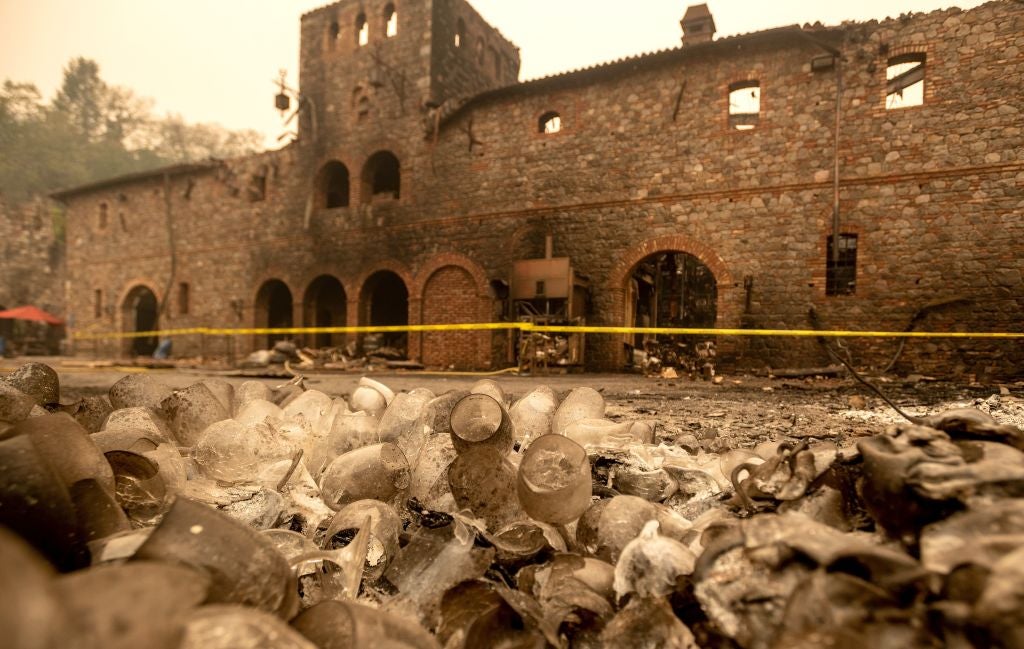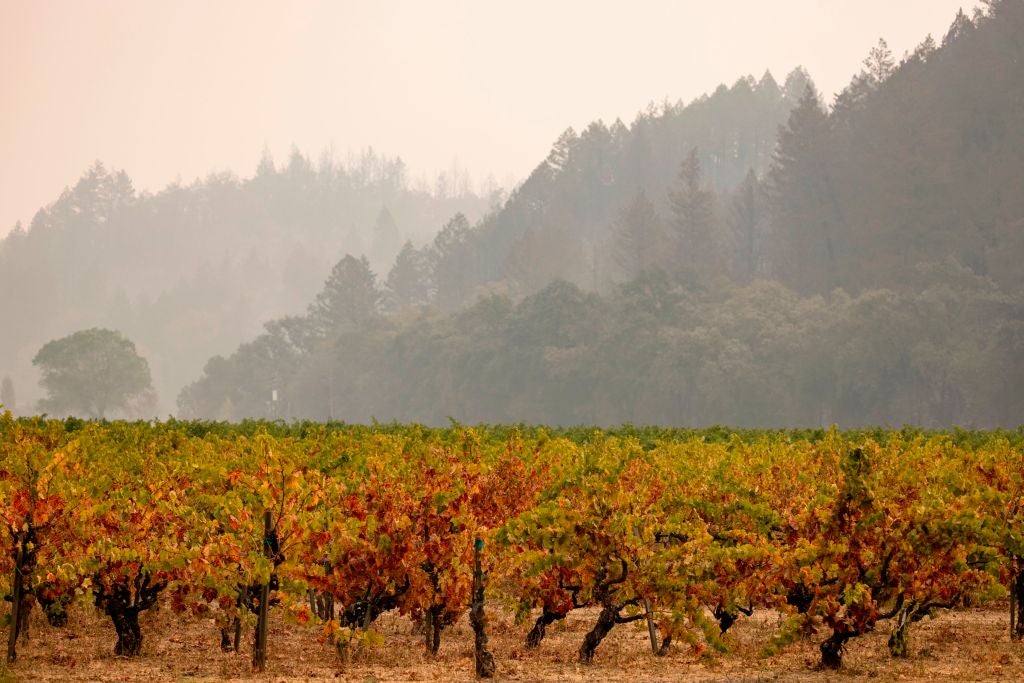How global warming is threatening Californian wine
Undrinkable wine could mean millions of dollars poured down the drain for a winemaker and the end of a business, writes senior climate correspondent Louise Boyle


Your support helps us to tell the story
From reproductive rights to climate change to Big Tech, The Independent is on the ground when the story is developing. Whether it's investigating the financials of Elon Musk's pro-Trump PAC or producing our latest documentary, 'The A Word', which shines a light on the American women fighting for reproductive rights, we know how important it is to parse out the facts from the messaging.
At such a critical moment in US history, we need reporters on the ground. Your donation allows us to keep sending journalists to speak to both sides of the story.
The Independent is trusted by Americans across the entire political spectrum. And unlike many other quality news outlets, we choose not to lock Americans out of our reporting and analysis with paywalls. We believe quality journalism should be available to everyone, paid for by those who can afford it.
Your support makes all the difference.In California wine country, there’s a waiting list arguably more prized than the three Michelin-starred French Laundry. It exists for a handful of laboratories capable of testing wineries’ smoke-damaged grapes in the wake of wildfires.
This damage, called taint, is a recurring problem for winemakers in the American west, where wildfires are now ripping across the landscape at an unprecedented rate.
Climate change is driving a confluence of problems for the $340bn (£270bn) global wine industry. Prolonged heatwaves and multi-year droughts, interspersed with erratic storms and record-setting rainfall, have upended the stability of agricultural seasons. And then, there are events which erupt with even less warning: wildfires.
Huge fires devastated wineries in Provence, France days before the 2021 harvest; winemakers in Greece, Italy, Portugal and Spain suffered similar impacts. In new world wine countries, blazes exploded across vast expanses of Australia and Argentina. California, Oregon and Washington, among the US’s top wine-producing states, have seen wildfires grow in size, ferocity and unpredictability in the past decade.
California has the largest US market share, making $43.6bn in 2021. In October 2017, a wave of wildfires devastated more than 100,000 acres in Napa and Sonoma counties, with the Tubbs Fire becoming the most destructive in the state to date. (It was overtaken by the Camp Fire the following year.)
Then, 2020. The LNU Lightning Complex, a monster blaze which saw several smaller fires combine, raged across 363,220 acres in wine country for six weeks from late summer into autumn, destroying 1,500 buildings and killing six people.
Even if they escape the flames, winemakers are not necessarily out of the woods. “Sometimes wildfires are 100 miles away, but the smoke will travel and sit in a valley for two weeks on top of the fruit,” Charles Slocum, co-founder of sensory sciences company Tastry, told The Independent.
Chemicals in wildfire smoke can be absorbed through grape skins, concealing their original taste and smell. If these grapes are then crushed into wine, it creates an unpleasant, even nasty taste, ranging from burnt and ashy to medicinal. Or even, as one taster suggested, “fecal plastic”.

Undrinkable wine could mean millions of dollars poured down the drain for a winemaker and the end of a business.
Following the devastating 2020 fire season, some California wineries requested that grapes be tested for smoke taint before they purchased the fruit. But due to how far-reaching the smoke damage was, labs could not keep up with demand.
California’s wineries lost an estimated $3.7bn, according to one of the industry’s leading analysts, due to both fire damage and grapes that were unusable from smoke exposure.
Testing for smoke taint can also be critical to provide evidence of a loss in order to claim on crop insurance. In September 2020, the situation was so dire that a group of west coast wine grape-growers and farming associations asked Congress for disaster relief.
“We fear these wildfires, and potentially more to come, will result in the greatest economic loss, due to a natural disaster, ever suffered by the industry in our states,” the letter read.
Katerina Axelsson, founder and CEO of Tastry, said that such was the devastation to the wine industry that she felt compelled to step in.
“We have a very advanced lab, and providing testing for typical smoke chain indicators was a relatively simple thing for us to do,” she told The Independent.
Axelsson, who began her career in the wine industry as a quality control chemist, created Tastry to provide a more science-based method for scoring wine. “Instead of being judged for not appreciating products rated highly by someone else, we expose all wine lovers and newbies to wines based on ratings produced by unique palate survey answers,” the company website explains.
It does so by using advanced chemistry, machine learning and artificial intelligence. “We like to say we taught a computer how to taste,” she says.
In 2020, that high-tech approach was pivoted to so-called “smoke taint amelioration” to predict how it would affect the taste, aroma, and texture of wine.
“We felt compelled to do it because there were only a few labs in the United States that were able, or advanced enough, to do this test. Very quickly, because of the wildfire season, they were inundated and turning people away,” Axelsson continued.
“Some had a 43-day backlog for analysis and people [needed] results in 48 hours or they would have to drop the fruit, losing millions of dollars. We felt if we repurposed a portion of our business operations in the lab to help some wineries not lose their businesses, that it would bring goodwill in the industry. So we created a method for smoke taint in record time.”
In the end, Tastry analysed samples for about 20 wineries, representing millions of gallons of wine. They worked alongside another company, Oak Wise, which uses oak and cherry tannin additives to mask or balance smoke characteristics either during fermentation, pre-bottling or in finished wine.
Atlas Wine Company, a Napa-based operation run by three families, was one which benefited from Tastry’s techy approach. Alexandre Remy, the managing partner, described it as an “insurance policy”.
“I’m a big fan of research and the wine industry is lacking of research quite a bit,” he toldThe Independent. “There’s not a lot of innovation. A bottle of wine from 100 years ago is the same as today, and the wine-making has not changed tremendously either.
“To me, Tastry is very interesting because I use it in many different ways. For the lab works – meaning the numbers on labels – and I use it to have an open mind on what I can do with my blend.
“And, if I have a challenge like smoke taint. Taint is a negative word – it’s a smoke impact which is a deviation of your goal. Grapes give you a product that is wine, and the smoke can impact that final product. Sometimes it’s unsellable, and sometimes it’s just an added challenge.”
This year, California is once again on edge. The forecast from Cal Fire, the state’s largest fire agency, notes that fire seasons are getting longer “as a direct result of climate change”.
This year winter and spring have been exceptionally dry, meaning the state will face its hot summer in moderate to extreme drought. These low moisture levels in vegetation and forests are an early warning system to the high risk of fire.
Yet no one is prepared to let the prized, and lucrative, wine industry go up in smoke, and millions of dollars in public and private money are being poured into potential interventions. In December, a $7.65m government grant was awarded to a joint effort from several west coast universities to further research “smoke to glass” impacts.
Ideas include lining vineyards with sensors to provide real-time risk assessments of smoke, and a de-facto “sunscreen” that would coat grapes with a substance to act as a barrier to smoke components.
“There are a lot of scientists coming at this from a lot of directions,” Slocum notes.



Join our commenting forum
Join thought-provoking conversations, follow other Independent readers and see their replies
Comments